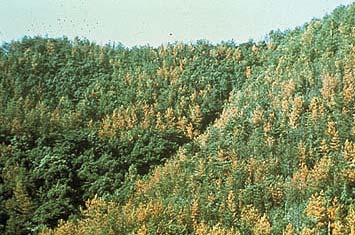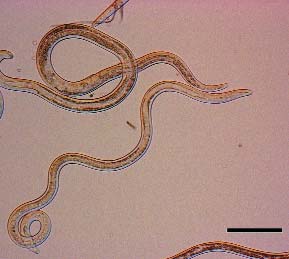PESTS AND DISEASES OF FORESTRY IN NEW ZEALAND
Biosecurity risk to New Zealand from pinewood nematode
From Biosecurity 55, November 2004.
MAF Forest Biosecurity has recently completed an assessment of the risk to New Zealand environment and economy posed by pinewood nematode, Bursaphelenchus xylophilus (PWN), the causal agent of pine wilt disease. From the risk assessment a number of recommendations have been made to improve New Zealand’s protection from this important forestry disease.

Pinewood nematode is a major forestry pest in a number of countries including Japan, China, Korea, Taiwan and Portugal. Pine wilt disease (PWD) is a severe hypersensitive response of susceptible pine trees against movement of PWN. This results in the blockage of xylem vessels and tracheids and the release of polyphenols, oleoresins and toxins.
Trees affected by pine wilt characteristically exhibit a rapid wilting and yellowing of the foliage and reduced resin production. Depending on the environmental conditions and susceptibility of the tree species, the disease may progress rapidly causing the tree to wilt and die within 3-4 months.
The nematode is indigenous to North America and in its native range it causes pine wilt to exotic pine species in warmer regions. Once introduced to Japan, China, Korea and Taiwan the disease caused extensive damage to both native and exotic pine species. Other recorded hosts of PWN include Douglas fir (Pseudotsuga menziesii), larch and spruce. The severity of the disease has led to the imposition of quarantine restrictions by other countries on the international movement of coniferous logs and forest products from countries known to have PWN.

By far the most common method of transmission of nematodes in the PWN group (Bursaphelenchus spp.) is from one tree to another by vectoring on wood boring insects. These vectoring insects are almost exclusively species of Monochamus (Cerambycidae) genus, commonly known as longhorn or sawyer beetles. For the nematode to spread, infected wood needs to be in a form that is attractive to the vectoring beetles, such as logs or fire wood. Within a localised area of infection, spread is generally a result of the activities of these vectoring beetles. Long distance spread occurs through the movement of infested wood in trade or travel and subsequent feeding on the infested wood by a vector.
MAF has recently become more concerned about PWN due to the increased global trade in PWN host material, the rapid spread of pine wilt in East Asia, and recent findings of pathogenicity of other Bursaphelenchus spp. It has also become evident that mere presence of this disease in New Zealand could impact on our export of New Zealand forest products.
The pest risk analysis of Bursaphelenchus nematodes assesses the risk of entry, establishment and spread in New Zealand of B. xylophilus, the most significant and intensively studied nematode of this group, and the potential economic and environmental consequences should it become established. The risk analysis identified the following factors significant to the biosecurity threat of PWN to New Zealand:
- New Zealand has suitable abiotic (temperature and annual precipitation) requirements for the establishment of PWN and host species (principally pine (Pinus radiata) and Douglas fir) are distributed throughout New Zealand.
- The establishment of PWN in New Zealand would mainly be dependent on the availability of a suitable insect vector. No species of Monochamus beetles are currently established in New Zealand. It is not known to what extent local native and exotic insects could act as a vector of PWN in New Zealand. The most possible candidates are the Cerambycids e.g. Arhopalus ferus (pine longhorn beetle) and Hexatricha pulverulenta (squeaking longhorn) which are both abundant in New Zealand.
- If PWN becomes established in New Zealand it is unlikely to show extensive pine wilt symptoms under current New Zealand climatic conditions.
- The most likely method of establishment of PWN is via Monochamus spp. carried by untreated coniferous wood packaging material. The likelihood of this occurring however is considered low.
Based on the findings of the risk assessment the following measures were recommended:
- All coniferous wood packaging material should be treated before entering New Zealand. Recommended treatments should exceed either fumigation with methyl bromide at 48 g/m3 for more than 24 continuous hours and at a minimum temperature of 10°C, or heat treatment to a
minimum continuous core temperature of 56°C for more than 30minutes. These treatments are expected to become mandatory for all imported solid wood packaging material during 2005. - General imported consignments should be monitored to ensure Monochamus spp. do not hitch a ride into New
Zealand on these products. - Surveillance should be undertaken for the early detection of Monochamus spp. in New Zealand at high-risk sites such as ports, container processing areas, timber yards, parks and nurseries.
- General surveillance should include the testing of dead or dying coniferous trees with wilt symptoms in climatically suitable areas for the presence of Bursaphelenchus spp.
The pest risk analysis also identified a number of areas requiring further research to improve our understanding of the risks of this disease to New Zealand.
For risk analysis report (pdf) : http://www.biosecurity.govt.nz/files/regs/imports/risk/pinewood-nematode.pdf
Shiroma Sathyapala,
National Adviser (Import Health Standards), MAF Forest Biosecurity

 Farm Forestry New Zealand
Farm Forestry New Zealand

